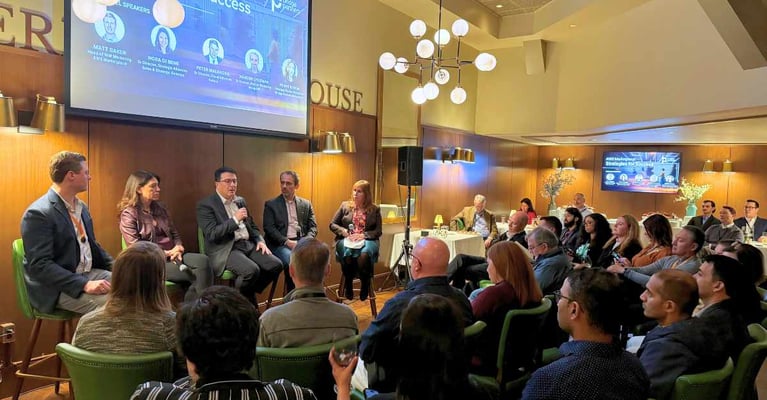

If you work for an independent software vendor (ISV), chances are good that you have recently discussed cloud marketplaces with a friend or colleague. If you are a partner marketing manager, alliance lead, or partner development manager, chances are good that you constantly discuss cloud marketplaces. According to Tackle.io, cloud marketplace transactions will reach $15B by the end of 2023 and $50B by the end of 2025. This rapid growth comes as no surprise to anyone who has been watching the “big three” hyperscale cloud service providers (CSP)—Amazon Web Services, Google Cloud Platform, and Microsoft Azure. However unsurprising this may be, a few macro trends have accelerated marketplace expansion.
The evolving B2B buyer journey: B2B purchases are increasingly seller assisted, rather than seller led. Gartner estimates that B2B buyers spend only 17% of their time meeting with potential suppliers. And research from McKinsey shows that 71% of B2B buyers are willing to spend $50,000 or more in a single self-serve transaction.
The end of all-you-can-eat capital: Tech companies of all sizes are adjusting to the realities of today’s economic environment. Approximately 168,000 jobs were shed in the first four months of 2023, and venture funding, after adjusting for outlier unicorns like Stripe and OpenAI, dropped 7% in the first quarter of this year.
When you add it all up, it’s clear that digital selling through the cloud marketplaces is here to stay. But what do you have to gain as an ISV? How will your customers benefit? And how do you make the most of this blossoming opportunity?
“What’s in it for me?” you ask.
The short answer is “a lot.” ISVs are piling onto cloud marketplaces to open a new route to market, capture existing untapped demand, accelerate deals, and grow the top line. More specifically, ISVs see immense value in co-selling with their CSP partner. 74% of ISVs surveyed by Tackle.io report that their decision to list on a cloud marketplace was driven by a desire to unlock co-sell opportunities. You don’t need a marketplace listing to co-sell and you don’t need to co-sell to sell through a cloud marketplace, but there are incredible synergies when these go hand in hand.
It’s not unusual for our customers to report that co-sell deals close 30-50% faster than direct sales opportunities. This isn’t a universal truth, but it’s an expectation held by many. When co-sell deals do close faster, it’s often because CSP partners can offer a direct path to budget owners and decision-makers and help streamline the procurement process.
Whether or not you accelerate pipeline velocity by co-selling through the marketplace, the more important point is that you’ll deepen customer relationships, strengthen partnerships, and increase customer lifetime value.
“Ok, but how do my customers benefit?”
Look at you, always having the customer’s back! Don’t worry, they have a lot to gain too. Not unlike the rest of us, your customers don’t want to waste time reviewing multiple iterations of the same contract and waiting to get through all the procurement hoops. Your cloud marketplace partner can help by providing universal agreements. You can amend these customer-friendly contract templates as needed and save everyone a few rounds of redlining.
Tactically, your customers will value the fact that they can utilize their committed cloud budget and draw down their commitment with the CSP. It also gives them a centralized console for billing and management. Big picture, they’ll get immense strategic value and better outcomes with technical and sales support from both companies.
Keys to success
So how do you take advantage of this opportunity and succeed as a cloud marketplace seller? Here are five best practices to keep in mind:
1. If you’re new to selling via cloud marketplaces, start small and start specific—market segment, industry, use case, cloud provider. Don’t try to do everything all at once.
2. Develop an offer strategy and rationalize your promotional touchpoints and target personas against your product SKUs. For example, if you think that developers are your entry point, build your campaign plan accordingly and drive to a listing that offers a free trial.
3. Understand that cloud marketplaces can act as a demand-gen channel for self-serve campaigns, especially for pay-as-you-go SaaS products. But they can also act as a procurement vehicle for traditional enterprise sales motions. Take a holistic view and build a cloud GTM that lays the groundwork for both scenarios.
4. Many marketplace sellers have products that are competitive with their CSP partner. But those who find a way to make those solutions complementary have much better luck in creating a joint value proposition. Build your better-together story at every level—from co-build all the way to co-sell.
5. Having said all that, don’t wait for perfection. Jump in! Test and learn. Know that listing your solution on a cloud marketplace might not be an immediate revenue-generating machine, but it will be a critical route to market in the long term and is a surefire way to help you build stronger relationships today with your hyperscale cloud partners.
Check back later for more blogs in our series on cloud marketplace activation or learn more here about all the ways that Bridge Partners can help you activate your partner ecosystem.
About the author

Tim Gunderson
As a Principal in the Digital Marketing Practice, Tim helps some of the most innovative cloud and tech companies in the world bring their message to the market. His thoughtful, pragmatic approach to demand gen marketing focuses on adding value and delivering tangible, cost-effective results for Bridge Partners clients. Tim holds an MBA from Seattle University and a BA from the University of Washington. Away from work, he enjoys all things basketball, eating, and traveling.



